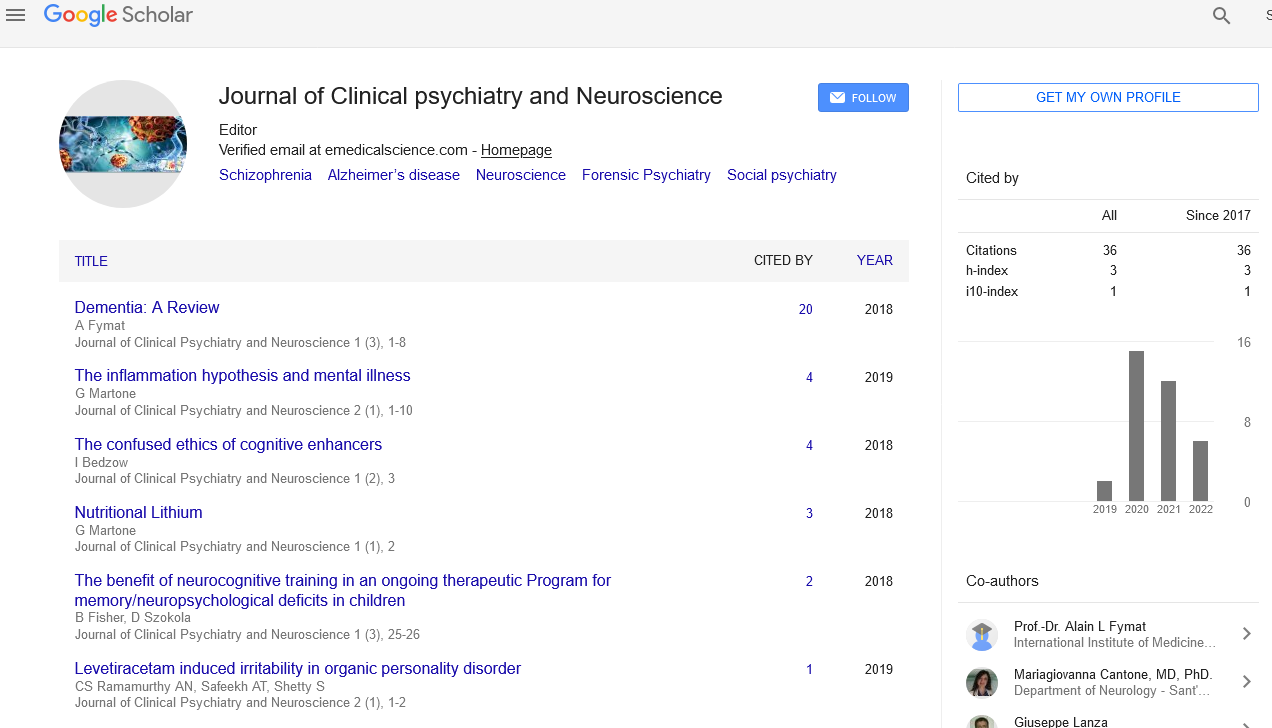Who is concerned about certain phobias?
Received: 07-Mar-2023, Manuscript No. puljcpn-23-6393; Editor assigned: 09-Mar-2023, Pre QC No. puljcpn-23-6393 (PQ); Accepted Date: Mar 26, 2023; Reviewed: 10-Mar-2023 QC No. puljcpn-23-6393 (Q); Revised: 11-Mar-2023, Manuscript No. puljcpn-23-6393 (R); Published: 27-Apr-2023, DOI: 10.37532/ puljcpn.2023.6(2).95-6
Citation: Cheron J. Who is concerned about certain phobias? J Clin Psychiatry Neurosci. 2023; 6(2):95-6.
This open-access article is distributed under the terms of the Creative Commons Attribution Non-Commercial License (CC BY-NC) (http://creativecommons.org/licenses/by-nc/4.0/), which permits reuse, distribution and reproduction of the article, provided that the original work is properly cited and the reuse is restricted to noncommercial purposes. For commercial reuse, contact reprints@pulsus.com
Abstract
Although specific phobia is one of the most common anxiety disorders in adults, little is known about the specific risk factors that contribute to its development. The study's overarching purpose was to examine the risk variables linked with worrying about Specific Phobias (SP) in a representative sample of community-dwelling people. The Australian National Mental Health Survey provided the sample of 8461 people. A total of 188 people (2.22%) expressed concern regarding SPs. Female sex Odds Ratio (OR) and a concomitant diagnosis of lifetime major depressive disorder were the characteristics most significantly related with worrying about SPs, according to multivariate logistic regression analysis. Having had traumatic encounters with significant individuals, a variety of chronic conditions and a concomitant diagnosis of drug use were also present.
Key Words
Anxiety, Major Depressive Disorder
Introduction
Our findings are consistent with previous research on other anxiety disorders. We present additional evidence that drug abuse appears to be a distinct risk factor for the future onset of SP. There is more discussion of empirical and therapeutic consequences. Fears are adaptive responses to impending threats, whereas phobias are exaggerated expressions of anxiety to items or circumstances in the absence of a comparable risk. A Specific Phobia (SP), according to the American Psychiatric Association's Diagnostic and Statistical Manual for Mental Disorders, 5th edition, is a severe and specific dread of a certain item or scenario. A phobia is also distinguished by apprehension about future interactions with the object or scenario. When confronted with the dreaded item or scenario, the individual often suffers anxiety, fear, or panic, and consequently does everything possible to avoid direct confrontation with the phobic stimuli. The individual avoids the issue, fearing great suffering if they attempt to cope with the feared circumstance. The anxiety is quite distressing.
SP was shown to be one of the most common lifelong anxiety disorders (12.5%) by Kessler and colleagues; however the prevalence might vary according on social and environmental factors such as wealth and geography. Wardenaar and colleagues, for example, gathered epidemiological data from 22 nations and estimated a 7.4% cross-national lifetime prevalence of particular phobia. Females had a greater lifetime and 12-month prevalence than males. Similarly, the authors found that the lifetime and 12-month prevalence of SP were greater in high/higher-middle income nations than in low/lowermiddle income ones. Overall, the lifetime frequency of SP varied greatly among nations, ranging from 2.6% in China to 3.4% in Poland and Japan and 12.5% in Brazil.
Several factors can explain the disparity in prevalence, including the criteria used to define phobia definitions, data collection methods, sample selection procedures, response bias, age, ethnicity, socioeconomic status of participants, time periods for risk estimation, and the varying number of objects and situations in which participants could report having fear or phobia. All of this complicates comparing prevalence across settings. Nonetheless, it appears that SPs can become chronic and disabling, affecting social, occupational, and physical functioning. Wardenaar and colleagues discovered that nearly one-fifth of persons with SP experienced significant role impairment in the previous 12 months.
According to the authors, the functional impairment may be explained in part by the significant comorbidity, which they observed to be present in 60.2% of patients with lifetime SP, with the beginning of SP usually preceding the other condition. Thus, SP is most likely an early indicator of psychopathology vulnerability, though the restricted lifestyle caused by fear and avoidance is most likely an independent contributor to impairment. Thus, the overarching goal of this study was to investigate the risk factors associated with SP anxiety in a representative sample of community-dwelling adults. We hypothesized that concern about SPs would be linked with age, sex, prior traumatic life experiences involving self and significant others, a history of Major Depressive Disorder (MDD), and drug addiction. To our knowledge, this is the only study to date that has investigated SP risk variables on a large representative population. Our findings could help counsellors, social workers, and other health professionals identify people who are at risk of developing an SP. These findings have implications for both preventative and therapeutic techniques.
In conclusion, this study adds to our understanding of the risk variables that lead to SP anxiety, which may enhance the likelihood of getting SP. We discovered that worrying about SP was connected with depression, female sex, seeing traumatic events in others, having a chronic condition, and having a comorbid diagnosis of substance use. Our findings have therapeutic relevance, since understanding the most significant risk variables might aid in both prevention and treatment of SP.





